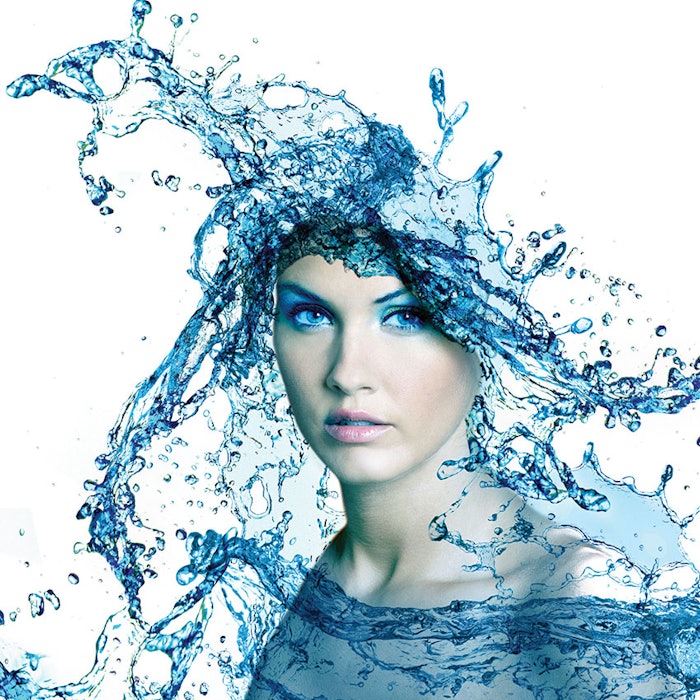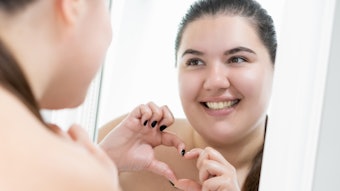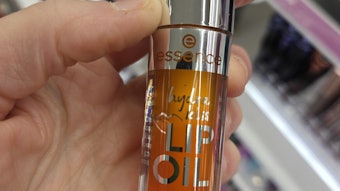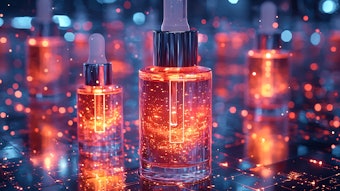
The equilibrium of cutaneous hydration is crucial and necessary to achieve an ideal skin condition. In fact, the “right” water content is essential to maintain various skin functions, including protection, elasticity, suppleness and plasticity.
The physiological loss of water from the skin must be carefully controlled. Indeed, the correct retention of water in the stratum corneum (SC) is dependent upon two major components: the presence of water-coordinating molecules within the corneocytes, and the SC intercellular lipids being orderly arranged to perform as a barrier to excessive trans-epidermal water loss (TEWL). In recent years, the aim of cosmetic products has changed—starting from the reduction of TEWL by occlusive or semi-occlusive films, through products containing natural-like moisturizing factors, to more complex approaches. Today, moisturizing efficacy is achieved by the synergy of several different approaches performing contemporarily in the same product through direct and indirect moisturization.
Water, Skin and the Principle of Moisturizers
Water is, by far, the most common compound in the body as it constitutes 45–75% of an individual’s total weight. We should consider two types of water: metabolic water, produced by synthesis reactions in the body, and pre-formed water, originating from the intake of drinks and foods. About two-thirds of body fluids are found inside the cells and constitute intracellular fluid. This fluid contains 75–90% water, as well as many enzymes, soluble proteins, nutrients and other ions, which are involved in the body’s metabolic reactions. The residual third, called the extracellular fluid, includes all the other body fluids. About 80% of the extracellular fluid consists of interstitial fluid, present in the space between blood capillaries and the cells. Interstitial fluid plays a key role in all exchanges between intracellular fluids and blood plasma.
Water as a whole, both intra- and extra-cellular, represents a substantial reservoir for the body. It is known that the water content of skin is remarkably high in the viable epidermis, while it sharply drops at the junction between the stratum granulosum and SC.1, 2 Following is a breakdown of the body’s water levels:
- The dermis consists of 99% water, which is found inside fibroblasts, within the extracellular matrix, and across the vessels constitutive of its rich vascular system;
- The living epidermis consists of 70–90% water; and
- The SC consists of 15–30% water.
The capacity of the skin to hold water is mainly related to the SC’s performance, which serves as a barrier to water loss. The amount of SC water for a “normal,” non-flaky skin appearance must be, in healthy tissue, more than 10%.3
Three types of water have been identified in the SC:
- Firmly bound, practically immobile water that is attached to the polar heads of lipids. This represents 3–5% of the composition of the SC.
- Bound (but not firmly) water that is mobile among the lipid layers. This represents 3–5% of the composition of the SC.
- Highly organized water or water fixed to the corneocytes via proteins, the water-holding protein filaggrin, and Natural Moisturizing Factor (NMF). This represents 10–20% of the composition of the SC.
For some time, skin hydration was linked primarily to the presence of natural hygroscopic agents within the corneocytes—such as amino acids and other small molecules comprising the NMF. As such, formulas (see Formula 1) were developed to address the breakdown of filaggrin, a protein that surrounds keratin filaments.
In the 1960s, the importance of lipids for proper barrier function was becoming more well-recognized and the ceramides family was identified, although largely unappreciated at this stage. Mineral oil and olive oil were shown to have minimal moisturizing effects in comparison to lanolin, and especially to petrolatum. Therefore, petrolatum became the gold standard of all moisturizers (see Formula 2 and Formula 3). Equally high concentrations of glycerin (25%) were shown to be effective for the relief of dry skin. Lactic acid and sodium lactate, and successively, pyrrolidone carboxylic acid (all components of NMF), were introduced into the formulae of dry skin creams. This evolution was parallel to studies for the complete understanding of the structure and biology of the stratum corneum.
From the initial brick and mortar model4 came a more refined scheme incorporating a fluid lipid phase: the sandwich model.5 The importance of ceramide 1 (CER EOS) linoleate in this phase, together with the long periodicity phase (LPP) and its vital role in barrier function, became progressively clearer (see Figure 1).6
Contrary to today’s eco- and skin-compatible commercial (and emotional) trends, in which a growing number oil-free, natural and organic claims have emerged, it is fair to underline that mineral oil is still widely used in cleansers, lubricants and products for massage. Moreover, several authors focus on the safety of cosmetic products containing mineral oil, even at high percentages.8–10 On the other hand, if used adequately, mineral oil can show higher moisturizing, emollient and skin-renovating properties than many vegetal emollients due to its inertia and chemical stability.11
The tools provided by cosmetic ingredients assembled in many efficient combinations become more refined every day.
Modern Moisturization
As stated, the water lost through human skin into the environment is essential for the functioning of a healthy and biologically active SC.12 This imperfect and inbuilt mechanism is key to allowing the hydration of the outer layers of skin, which maintains its flexibility and more importantly, provides enough water to allow enzyme reactions that facilitate SC maturation events. Various factors can interfere with this balance and induce dry skin conditions, such as atopic dermatitis, winter xerosis, aging, poor cleansing habits, atmospheric conditions, etc.13 For this reason, cosmetic strategies to counteract dry skin must be articulated.
While the use of NMF-like ingredients in formulas has already been stressed, one may also introduce long-chain, emollient lipids. A closer look at the skin barrier reveals that one of its two main components is an interspersed, “hydrophobic” substance among corneocytes—the barrier lipids. Neutral lipids such as fatty acids and cholesterol, and ceramides are the main constituents of this lipid phase, and they are responsible for the control and limitation of water transport through the skin.14 Many studies have focused on identifying specific ceramide subclasses or lipid species that play a key role in processes that maintain skin barrier integrity.
In atopic dermatitis, a significant reduction in the linoleic acid-containing u-acylceramide [EOS] was found. The authors confirmed the importance of this ceramide for skin barrier properties. Likewise, Di Nardo and co-workers reported diminished u-acyl-ceramide levels in the skin of atopic dermatitis patients, as well as a reduced ceramide [NP] level, which was assumed to account for the impaired transepidermal water loss observed for this non-physiological skin state. A strong reduction of the phytosphingosine-based ceramide [AP] and [NP] has also been demonstrated for psoriatic skin.15
It is therefore evident that applying products such as those shown in Formula 4, which restore ceramides to the skin, could have a significant positive effect on hydration and TEWL. For instance, in SLS-damaged skin, an emulsion containing ceramides 1 and 3 showed positive synergistic effects on skin hydration and TEWL, compared with a control.16
Further, the cell membranes of keratinocytes include lectin-type receptors, some of which have good affinity for certain oligosaccharides. In skin, these sugars are rarely present in free form; on the contrary, they are generally found in the form of conjugated saccharides such as:
- Glycoprotein = protein + oligosaccharide chains
- Glycolipid = lipid + oligosaccharide chains
- Proteoglycan = protein + very long chain glycosaminoglycans
Hyaluronic acid (HA) is well-known as one of the major components of the dermis. This hydro-coordinating polymer of sugar molecules provides hydration and structural integrity to the dermis. However, it has been reported that HA is also naturally present in the epidermis, bound to the extracellular space via the cell-surface glycoprotein CD44, where it may play a role in epidermal barrier function and SC hydration.17, 18 In relation, HA fragments may act as humectants as well, and they are essential for cell functions such as influencing cell-to-cell and cell-to-matrix contacts.19
As a high molecular weight polymer, HA delivered via cosmetic recipes acts mainly on the outer part of the epidermis. It has substantial water-retention properties, providing skin moisture and re-plumping effects. In recent years, new, low molecular weight, hydrolyzed hyaluronic acid (LMW HA) has been employed (see Formula 5). These LMW HAs of approx. 50 kDa show better skin penetration capability and appear to influence the expression of various genes, including those contributing to keratinocyte differentiation and the formation of intercellular tight junction complexes.20
Similarly, several new oligosaccharides and polysaccharides have been developed to mimic the efficacy of HA. Biosaccharide gum-1, obtained by means of bacterial fermentation from substrates of vegetable origin, e.g., maize sorbitol and soya peptone, is an anionic polysaccharide sequence having a high molecular weight (~106 Da), with a linear structure of three repeating sugars units: L-fucose, D-galactose and galacturonic acid. Tamarindus indica seed polysaccharide, a fraction obtained from the seed of tamarind, with a cellulose-type backbone (b-(1-4)D-glucose), carries xylose and galactose constituents and was shown in vivo to immediately increase skin hydration and to improve skin moisture—better than sodium hyaluronate. Moreover, it positively influenced elasticity, roughness and skin density parameters.21
Skin represents the field of action of cosmetics, and skin moisturization is essential for its equilibrium and functionality.
Glycerol also is a well-known cosmetic ingredient, although its true role as natural endogenous humectant was elucidated only recently. Two unrelated animal models clarified the importance of endogenous glycerol for normal SC hydration. Mice with hypoplastic sebaceous glands displaying low levels of SC hydration were correlated with reduced SC glycerol levels.22 In addition, aquaporin 3 (AQP3) transgenic mice, which lack the water/glycerol channel, were unable to transport glycerol from the bloodstream to the epidermis, and displayed abnormal SC hydration and reduced SC glycerol levels.23 Moreover, topically applied glycerol corrected the hydration abnormality in both animal models, whereas topical sebaceous lipids did not work similarly.
Discovered in 1988 by Peter Agre, M.D., for which he was awarded the Nobel Prize in Chemistry in 2003, aquaporins (AQP) are a family of transmembrane proteins, present in the cell membrane. They form small channels that are permeable to water molecules, thus facilitating the transport of water and hydration of the epidermis.24, 25 Aquaporins 3 and 9, members of the family of aquaglyceroporins, are present in the cell membrane of human keratinocytes and play an important role in skin hydration. They are involved particularly in the transport and distribution of water and solutes such as glycerol or urea.26 In the viable epidermis, AQP3 provides a shortcut for water distribution between the base of the epidermis and the SC, in order to maintain constant water levels. This recent discovery spurred several studies in the quest for single ingredients or combinations to potentially enhance the expression of AQPs. Studies have investigated trace minerals present in thermal water,27 synthetic hexapeptides and highly purified plant extracts such as Ajuga turkestanica.28
Conclusions
Skin moisture is based on the complex interactions of several structures and molecules, as well as deeper skin layers; plus external environmental factors. A universe of biological and transport phenomena take place simultaneously in this outer body layer.
As skin represents the field of action of cosmetics, and skin moisturization is essential for its equilibrium and functionality, cosmetic formulators are continuously challenged by new discoveries in the fields of dermatology, physiology and biology concerning the skin-water equilibrium. However, the tools provided by cosmetic ingredients assembled in many efficient combinations become more refined every day, helping humans to live more and more comfortably within their own boundaries—and skin.
References
- S Verdier-Sévrain and F Bonté, Skin hydration: A review on its molecular mechanisms, J Cos Derm 6 75–82 (2007)
- S Bielfeldt et al, Assessment of human stratum corneum thickness and its barrier properties by in vivo confocal raman spectroscopy, IFSCC Magazine 12(1) (2009)
- IH Blank, Factors which influence the water content of the stratum corneum, J Invest Dermatol 18 433–40 (1952)
- AS Michaels, SK Chandrasekaran and JE Shaw, Drug permeation through human skin. Theory and in vitro experimental measurements, AICHE J 21(5) 985–996 (1975)
- JA Bouwstra et al, Role of ceramide 1 in the molecular organization of the stratum corneum lipids, J Lipid Res 39 186–196 (1998)
- AV Rawlings, 50 years of stratum corneum and moisturization research, IFSCC Magazine 12(3) (2009)
- ME Johnson, D Blankschtein and R Langer, Evaluation of solute permeation through the stratum corneum: Lateral bilayer diffusion as the primary transport mechanism, J Pharm Sci 86 1162–1172 (1997)
- JC Di Nardo, Is mineral oil comedogenic? J Cosm Derm 4(1) 2–3 (2005)
- JF Nash et al, A toxicological review of topical exposure to white mineral oils, Food and Chemical Toxicology 34(2) 213–225 (1996)
- ST Lorena et al, The infant skin barrier: Can we preserve, protect and enhance the barrier? Derm Res and Practice (2012)
- GN Stamatas, Safety profile, lipids and skin health, Mineral Oil in Skin Care (2015) pp 291–299
- AV Rawlings and PJ Matts, Stratum corneum moisturization at the molecular level: An update in relation to the dry skin cycle, J Inves Derm 124 1099–1110 (2005)
- M Lodén and HI Maibach, Dry Skin and Moisturizers: Chemistry and Function (Dermatology: Clinical & Basic Science), 2nd edn, CRC Press, Boca Raton, FL (2005)
- P Wertz and L Norlén, “Confidence intervals” for the “true” lipid composition of the human skin barrier? in Skin, Hair and Nails, Marcel Dekker Inc., New York (2004) pp 85
- TN Engelbrecht et al, The impact of ceramides NP and AP on the nanostructure of stratum corneum lipid bilayer. Part I: Neutron diffraction and 2H NMR studies on multilamellar models based on ceramides with symmetric alkyl chain length distribution, Soft Matter 8 2599–2607 (2012)
- HC Huang and TM Chang, Ceramide 1 and ceramide 3 act synergistically on skin hydration and the transepidermal water loss of sodium lauryl sulfate-irritated skin, Intl J Derm 47 812–819 (2008)
- R Tammi et al, Localization of epidermal hyaluronic acid using the hyaluronate binding region of cartilage proteoglycan as a specific probe, J Invest Dermatol 90 412–4 (1998)
- S Sakai et al, Hyaluronan exists in the normal stratum corneum, J Invest Dermatol 114 1184–7 (2000)
- M Brecht et al, Increased hyaluronate synthesis is required for fibroblast detachment and mitosis, Biochem J 239 445–50 (1986)
- M Farwick et al, Fifty-kDa hyaluronic acid upregulates some epidermal genes without changing TNF- expression in reconstituted epidermis, Skin Pharmacol Physiol 24 210–217 (2011)
- G Maramaldi, Tamarindus indica xyloglucan, Cosmetic Technology 14(5) 17–21 (2011)
- JW Fluhr et al, Glycerol regulates stratum corneum hydration in sebaceous gland deficient (asebia) mice, J Invest Dermatol 120 728–37 (2003)
- M Hara, T Ma and AS Verkman, Selectively reduced glycerol in skin of aquaporin-3-deficient mice may account for impaired skin hydration, elasticity and barrier recovery, J Biol Chem 277 46616–21 (2002)
- M Boury-Jamot et al, Expression and function of aquaporins in human skin: Is aquaporin-3 just a glycerol transporter? Biochim Biophys Acta 1758(8) 1034–42 (2006)
- M Hara-Chikuma and AS Verkman, Physiological roles of glycerol-transporting aquaporins: The aquaglyceroporins, Cell Mol Life Sci 63(12) 1386–92 (2006)
- R Sougrat et al, Functional expression of AQP3 in human skin epidermis and reconstructed epidermis, J Invest Dermatol 118 678–85 (2002)
- F Joly et al, Beneficial effect of a thermal spring water on the skin barrier recovery after injury: Evidence for claudin-6 expression in human skin, J Cosmetics, Derm Sciences and Applications 2 273–276 (2012)
- M Dumas et al, Effect of an Ajuga turkestanica extract on aquaporin 3 expression, water flux and differentiation and barrier parameters of the human epidermis, Eur J Dermatol 12 XXV–XXVI (2002)










